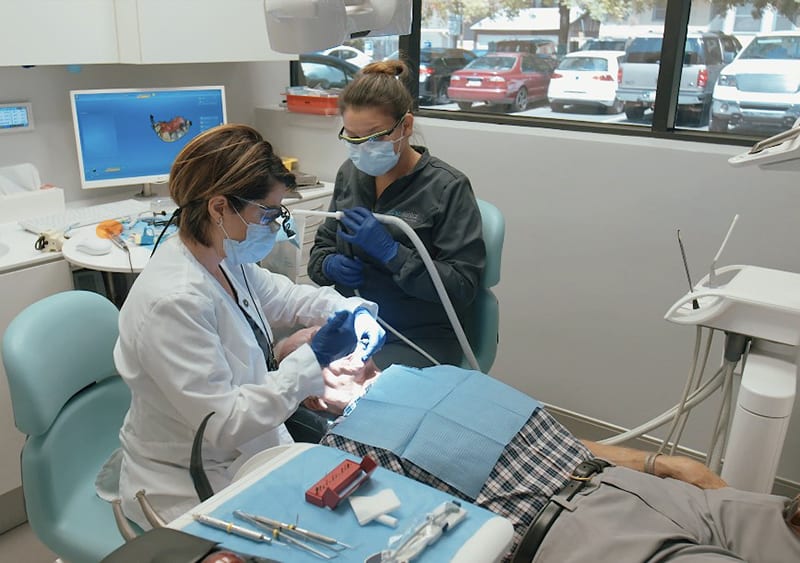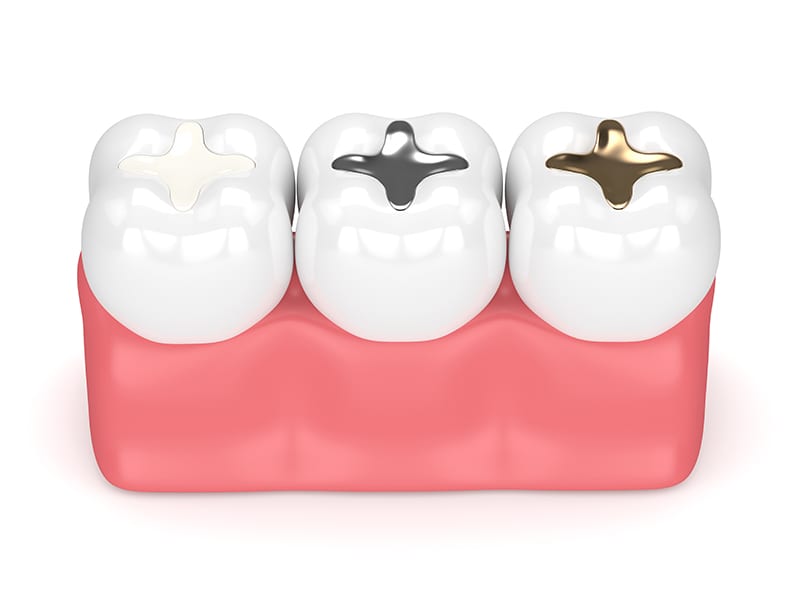Tooth Pain? Think you have a cavity?
Get a professional dental filling from our friendly staff.
Do you have pain or discomfort coming from one of your teeth? It could be coming from damaged or decayed teeth. Luckily, if caught early by your dentist, a simple dental filling can be the first step in restoring your oral health!
At Midtown Dental we have helped patients just like you alleviate their pain and discomfort with our simple dental filling process. Many patients can have their damaged tooth or teeth repaired in just one convenient dental appointment.
I recently had to switch dentists for convenience to my work. I decided to try this practice and I’ve had a great experience each time I’ve gone. I’ve had an exam, cleaning and filling and everyone is friendly. Dr. Crippen has been on time, efficient and thorough.
Top 7 Signs A Dental Filling May Be Right for You
Dental fillings can be part of many different treatment plans. Seven of the most common causes which require a dental filling include:
- Tooth Decay from A Cavity – Tooth decay is one of the most common oral health issues treated with dental fillings in our office. There are many reasons you may experience tooth decay, including harmful bacteria in your mouth, frequently drinking sugar sweetened beverages or snacking on foods which are high in sugar, and poor oral hygiene habits. Some of the most common symptoms of tooth decay or cavities include toothaches, tooth sensitivity, bad breath, noticeable holes, pits, or discoloration in the tooth enamel, and pain while drinking or eating.
- Accidental Chipping or Cracking – Tooth enamel is generally very strong when properly cared for with good oral hygiene. However, a strong impact to the jaw such as a car accident, a blow in a fight or sporting event can cause a chip or crack in the enamel. Depending on the amount of damage to the tooth, a dental filling may be a part of your treatment plan. When there are large amounts of damage, a Crown for Teeth or even a Dental Implant may be required.
- Grinding or Clenching of Teeth – Tooth enamel can be worn down due to grinding or clenching your teeth while sleeping, doing intense activities, or in just everyday life. Occasional grinding or clenching may have little or no negative damage to the teeth. However, an oral health issue called Bruxism caused by prolonged teeth grinding, can cause more damage.
Many patients tend to grind or clench their teeth in their sleep without realizing it. Common symptoms include waking up with a sore jaw and/or a dull headache. Your dentist may also recommend a mouth guard to help minimize damage. - Chewing on Hard Objects – Occasionally or consistently chewing on hard objects or foods can cause tooth damage. Biting on hard foods like ice, nuts, or hard candies or chewing on pens or pencils have been known to cause chips and cracking in teeth.
- Uneven Pressure from Chewing – Tooth enamel can be damaged when pressure is not evenly distributed across your teeth. This is a common side effect of favoring one side of your jaw when chewing food because of pain or discomfort caused by a damaged or missing tooth in another part of the mouth. When damage to the tooth enamel is caused by uneven chewing pressure, it is equally as important to not only repair the damaged teeth, but also the root cause of the problem. Sometimes the cause can be from malalignment of the teeth which can be corrected with orthodontics such as Invisalign.
- Normal Wear of Enamel – Unfortunately, even with good oral hygiene practices, tooth enamel can wear down over time and lead to cavities. Factors like genetics will also play a role in how strong your enamel is.
A preventive oral care strategy that includes regular six-month dental exams and cleanings along with proper brushing and flossing habits are the best way to prevent natural enamel wear. - Replace Worn or Old Fillings – With proper care and maintenance, dental fillings can last a long time. However, even with great care, most fillings will need to be replaced at some point. The estimated lifespan of filling depends on the type of material used. Generally, fillings can last between 5-15 years. The most common reason we find patients want to replace a dental filling is cosmetic. Thanks to advancements in materials available for fillings, patients can now choose to have old silver fillings made from amalgam replaced with a tooth colored filling made from composite materials.
Ready for a Dental Fillings Visit?
Common Types of Dental Filling Materials
There are three commonly used materials by dentists for dental fillings, composite resins, dental amalgam, and precious metals (gold fillings).
Composite Resins – Referred to as white or tooth-colored fillings, fillings made from a composite resign are the most common type of fillings used at Midtown Dental. Made from a mixture of glass or quartz filler, composite resin fillings provide a high level of durability and resistance against future damage. Your dentist can carefully match the color of the resin to your natural teeth. Composite fillings can last between five to ten years with proper care and maintenance.
Dental Amalgam – When most people think of a traditional dental filling, they will commonly think of dental amalgam or silver fillings. Amalgam fillings were the most popular type of material used by dentists before the development of composite fillings. The amalgam can be created through a combination of materials including silver, mercury, tin, and copper.
Although amalgam fillings are an affordable and durable option, many dentists have moved away due to public safety concerns about the materials and aesthetic reasons. Many patients will now request their old silver fillings be replaced with a composite filling to provide a more natural look to their teeth.
Precious Metals (Gold Fillings) – Gold fillings are one of the oldest forms of filling material used by dentists for more than 1,000 years. Also referred to as an inlay or onlays in the dental field, they are very durable however, due to the high cost and inability to match to the natural tooth color make them an unpopular filling option.
For my second visit, Dr. Apekian and Sara both worked on replacing my fillings. They were both super friendly and social. Before they began, we talked about shows we were binge watching, lol, this definitely broke the ice and made me feel comfortable. They were very detailed and thorough on what they were going to do and Dr. Apekian made sure I was in no pain or had any discomfort during the process. This definitely showed Dr. Apekian’s compassionate side. Not once during any of my visits, did anyone, including Dr. Apekian, try to up-sell me on any additional services that were not needed.
Dental Filling Process
With every dental treatment performed at Midtown Dental, our goal is to provide you with the most calming and comfortable experience possible. To alleviate any dental anxiety you may experience, we can offer sedation dentistry options, as well as our patient comfort menu.
While every dental treatment can vary depending on your unique needs, a typical dental filling treatment will follow this process.
- Exam and X-ray: When you are already experiencing pain, your dentist will speak with you to learn more about the type of pain you are experiencing. They will also want to know if any specific activities that cause or elevate the pain. Your dentist will then have an x-ray taken to get a better understanding of the damage or decay you are experiencing. They will then examine the problem area, along with the surrounding teeth.
- Tooth & Gum Prep: Once your dentist has identified the problem and decided on a treatment plan, then will begin the preparation process. To minimize any pain or discomfort you may experience during the procedure, your dentist will administer a local anesthetic to the area. This will allow the gums and tooth’s roots to become numb during the procedure and minimize pain. The effects will generally wear off within a few hours.
- Removal of Decay and Damage: When the anesthetic has taken effect, your dentist will begin to prepare the tooth for restoration. Special dental instruments are used to remove any decay and damaged areas of the tooth. While you may feel vibrations in your gums and jaws, the local anesthetic should prevent any pain or discomfort. After the damage and decay has been removed, the area will be cleansed with an acid gel that is applied to the tooth which removes any bacteria and/or debris.
- Filling Composite and Placement: With the area prepped, your dentist will mix the composite filling material. During the mixing, they will take great care to match the composite to the natural color of your teeth for aesthetic purposes. To prevent moisture from entering the area, the tooth will be isolated from the surrounding teeth. To help create a strong bond between the tooth and filling, various adhesives will be applied to the tooth. The mixed composite material is then placed onto the adhesives and shaped to match your natural tooth. A special bonding light is then placed on the material to harden the filling.
- Polishing and Final Adjustments: The final step of the dental filling process will have your dentist do a bite check or bite test. This is done to ensure that your restored tooth lines up with your natural bite pattern. If needed, any high points that are revealed with the bite check will be removed with the use of special dental tools. After your dentist is satisfied with the results, the tooth will be polished, and you can see you restored tooth.
- Aftercare and Future Prevention: After your treatment has been completed, your dentist will review how to care for your new filling as well as prevent future damage. As with all dental treatments, good oral hygiene habits, including good home brushing and flossing practices, along with regular dental exams and cleanings, will help extend the life of your dental filling and prevent future issues.
Quit living with pain in your mouth!
Contact our office to schedule an appointment
and get relief in just hours!
Call today at (916) 441–5800 to learn more about our Periodontal Dentistry services.


